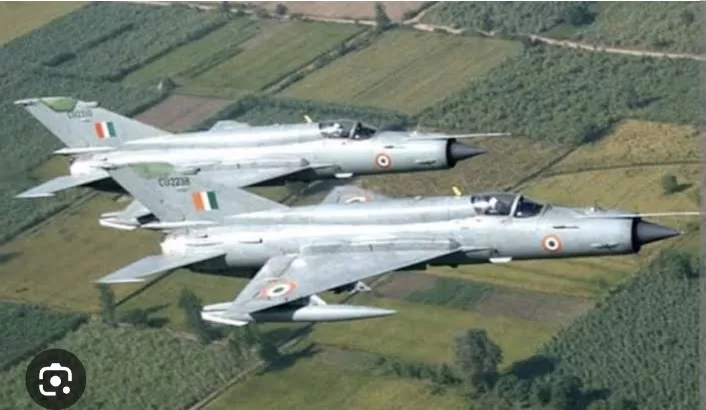In a demonstration of unparalleled strategic acumen, the United States is orchestrating exercises aimed at enhancing its combat prowess against adversaries Russia and China. Following the triumphant conclusion of the Malabar naval exercise among Quad nations in the Indo-Pacific, the US is meticulously preparing for Exercise Bright Star-23 in Egypt. This upcoming maneuver is set to pitch US aviators against the Indian Air Force’s (IAF) Russian-origin MiG-29 fighters.
Preliminary reports indicate that Pakistan is actively participating in the exercise with its JF-17 ‘Thunder’ aircraft, a notable choice as the US embargo restricts the inclusion of F-16s for such ventures.
The IAF contingent has embarked on its journey to partake in the tri-service exercise, scheduled to unfold at the Cairo (West) Air Base, Egypt, from August 27 to September 16. Eclipsing all precedents, this marks the IAF’s inaugural participation in Exercise Bright Star. The cohort of participating countries includes the US, Saudi Arabia, Greece, and Qatar.
Manifesting its commitment to international collaboration, the IAF has assembled a robust ensemble of assets for the exercise. Comprising five MiG-29s, two IL-78s, two C-130s, and two C-17 aircraft, the contingent reflects a fusion of prowess and tactical prowess. Diverse units, including the IAF’s Garud Special Forces and squadrons such as 28 (First Supersonics), 77 (C-130J ‘Veiled Vipers’), 78 (Il-78 ‘Valorous’), and 81 (C-17 ‘Sky Lords’) will actively contribute. Furthermore, the IAF’s transport aircraft are poised to facilitate the airlift of approximately 150 personnel from the Indian Army.
The exercise’s underlying objective lies in refining the intricacies of joint operations, encompassing meticulous planning and astute execution. Affectionately deemed “Diplomats in Flight Suits,” the IAF contingent strives to foster enduring strategic relationships between the participating nations.
Hailing the backdrop of profound camaraderie and cooperation between India and Egypt, it is noteworthy that the two nations have jointly pursued the development of aero-engines and aircraft during the 1960s. Additionally, India has played an instrumental role in training Egyptian pilots.
Signifying a transformative leap forward, the upgraded Indian MiG-29 variant stands as the pinnacle of technological advancement among the Mikoyan MiG-29 fighter jets. Origination from the crucible of the Cold War, the MiG-29 emerged as a countermeasure to the formidable US F-16 Fighting Falcons and F/A-18 ‘Super Hornets’.
The IAF’s induction of MiG-29B variants in 1986 marked a watershed moment. Outfitted with medium-range Beyond Visual Range (BVR) missiles, these aircraft proved instrumental in neutralizing Pakistani F-16s during critical operations, including ground support missions in Kargil. Notably, the MiG-29s provided protective cover to Mirage-2000s during bombing sorties in Kargil.
Underpinning the IAF’s relentless pursuit of excellence, all MiG-29s within its inventory underwent comprehensive upgrades by 2022. Reflecting on this transformation, Sergei Korotkov, the Director-General of MiG, commended the pivotal role of the MiG-29UPG variant, developed collaboratively with Indian industry expertise. This strategic enhancement has reinvigorated the operational lifespan of MiG-29s within the IAF, with their service projected to extend until 2035.
The post-upgrade landscape witnesses the aircraft armed with very long-range air-to-air missiles and air-to-ground armaments. Capitalizing on emergency procurement authority, the IAF has fortified its arsenal with lethal weaponry, empowering the upgraded fighters for air-to-ground operations and introducing enhanced endurance through air-to-air refueling capabilities.
Addressing the historical challenge of limited range, the upgraded MiG-29 variant is now bolstered by an additional fuel tank, significantly augmenting its operational reach. This acumen aligns with the IAF’s strategic vision, whereby the upgraded MiG-29s emerged as pivotal assets in the aftermath of the Balakot strike against Pakistan in 2019 and the Galwan confrontation with China in 2020. The squadron’s illustrious designation as “the Defenders of the North” stands as a testament to their mettle and dedication.
The MiG-29, often referred to as ‘Fulcrum’ in NATO parlance, took flight for the first time in 1977 and was inducted into the Soviet Air Force in 1983. With an extensive footprint spanning over 25 countries, including the US, this twin-engine marvel has significantly shaped the landscape of aerial combat. The US’ strategic assessment during the Cold War underscored the MiG-29’s potency and maneuverability, as it sought to counterbalance burgeoning Soviet technological advancements.
The US’ procurement of MiG-29s from the economically challenged Soviet Republic of Moldova reflected a strategic effort to mitigate their delivery to Iran. Furthermore, the potency of Soviet technology posed a formidable challenge to US aircraft capabilities, with the MiG-29s emerging as exemplars of maneuverability and combat efficacy.
Furthermore, the allure of MiG-29s has transcended geopolitical boundaries. As European nations grapple with delays in supplying F-16 fighter jets, the mantle of benevolence has seen countries such as Slovakia and Poland extend the gift of MiG-29s to Ukraine, amplifying the aircraft’s prominence.
In the epic arena of aviation, the IAF’s contemporary MiG-29s are poised to magnificently engage their US counterparts, symbolizing a convergence of cutting-edge capabilities and resolute determination.




